Market movers ahead
- In the euro area, we are due to get the last inflation input before the ECB meeting in September, setting the scene for the monetary stimulus package. We expect August inflation to be unchanged from July inflation.
- We do not expect to see any improvement in numbers out of Germany, as the Ifo index is set to decline further on the back of ongoing geopolitical uncertainty.
- In the US, we are set to get preliminary capex orders for July, which will be interesting in light of the ongoing manufacturing slowdown and trade war uncertainty.
- Focus remains on Brexit and whether the anti-hard Brexiteers can find a common way forward to block Prime Minister Boris Johnson delivering a no-deal Brexit.
- Danish data next week should shed light on what has been driving the strong Q2 GDP reading. In contrast, we expect Swedish data to show weakness.
Weekly wrap-up
- We have published an update on our outlook for the global economy (see Global Economic Update: Stuck in the mud but no hard landing yet , 22 August) . With no solution to the trade war in sight, we have downgraded our growth outlook.
- The FOMC minutes from the July meeting revealed a very divided Fed on the topic of further easing, inflation expectations continue to slide and US PMI manufacturing moved below 50.
- In the euro area, the economic backdrop remains gloomy and the ECB confirmed that it plans to unveil a stimulus package in September but did not give any clues on the exact design and magnitude of policy measures included.
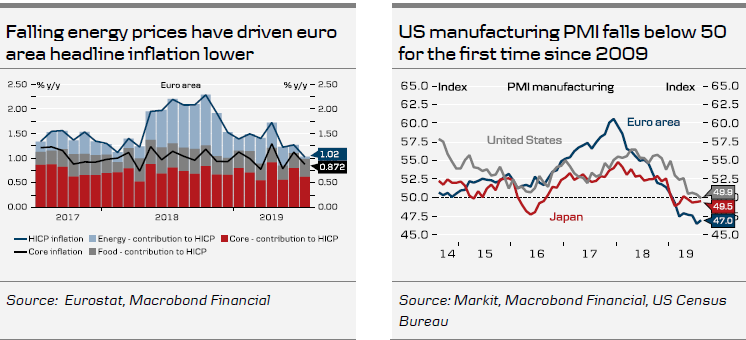
Global
In the US, we have a few interesting data releases next week. On Monday, preliminary capex orders in July are due, which will be interesting in the light of the ongoing manufacturing slowdown (recession?) and trade war uncertainty. It seems that many companies are reluctant to invest in the current environment. On Friday, PCE data for July are due to be published. We expect PCE core rose +0.2% m/m in July, implying an unchanged PCE core inflation rate at 1.6%. Retail sales suggest private consumption grew strongly in July.
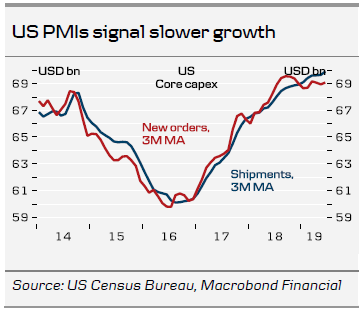
On the back of Fed Chair Powell’s speech today (the content was not known at the time of publication), it will be interesting to hear from the other FOMC members given the high expectations of further Fed easing. We expect a 25bp cut at each of the next five meetings, taking the target range to 0.75-1.00% in March, see Presentation: Five more cuts from the Fed (chart pack), 20 August.
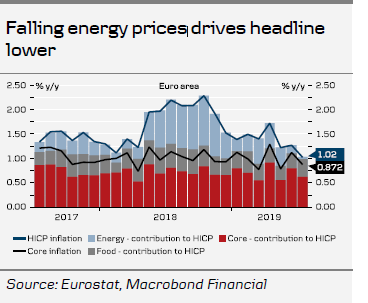
In the euro area, we have an important data release on Friday when the August inflation print ticks in. This will be the last inflation input before the ECB meeting in September, hence setting the scene for the monetary stimulus package. In July, headline inflation fell to a three-year low of 1.0% y/y, while core inflation stood at 0.9% y/y - just below the 1.0% level it has hovered around for the last five years. We expect the headline print to remain at 1.0% y/y, since energy prices have fallen substantially since August last year and we likewise foresee core inflation staying at 0.9% y/y.
Furthermore, we get the German Ifo print on Monday. We expect the current situation print to fall in line with the weak ZEW and the expectations component to fall on the back of ongoing geopolitical uncertainties.
In the UK, we have a quiet week ahead of us without any really interesting data releases. Focus remains on Brexit and whether the anti-hard-Brexiteers can find a common way forward to block PM Boris Johnson delivering a no-deal Brexit.
In Japan, we get the July industrial production data on Friday. The manufacturing sector is still the one suffering the most from weaker global demand. PMIs point towards another weak month. On the same day, retail sales tick in. Domestic demand has remained fairly robust, supported by a tight labour market.
It’s a quiet week in China on the data front. Industrial profit growth for July is likely to continue to hover around zero (see chart). Focus continues to be on trade tensions with the US where more news on a planned face-to-face meeting in Washington in September is awaited.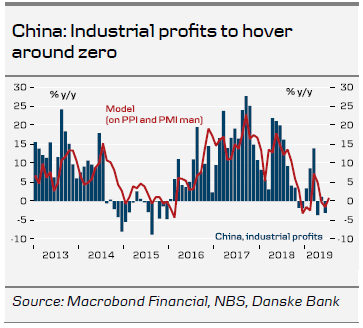
Scandi
In Denmark, a number of key economic figures are due in the coming week which could potentially provide a better insight into the latest economic developments, as the figures so far have not painted a clear picture.
Statistics Denmark will be publishing several figures towards the end of the week. Business confidence for August is due on Thursday, and this fell last month for both the industrial and the service sector. Industrial production declined by a significant 6.8% in June, and while the Danish economy is continuing to grow, confidence will probably continue to be affected by the global industrial slowdown. Unemployment figures are due on the same day. The latest employment figures have indicated a slowdown in the labour market, and it will be interesting to see if this is also reflected in unemployment. Friday should bring details of the national accounts. The GDP indicator showed strong growth of 0.8%, which we expect was driven mostly by foreign trade, while domestic demand has been more modest. Finally, we will get Statistics Denmark’s house price figures for June.
Danmarks Nationalbank is scheduled to publish figures for the currency reserve, foreign portfolio investments and the securities statistic. The Danish krone (DKK) has strengthened in August and is now trading below the central parity rate again, so intervention seems unlikely.
In Sweden the outlook for household lending is somewhat opaque, in particular mortgage lending which constitutes about 80% of the total. The reason is that basic forces move in different directions: property prices have stabilised, propelling demand, while a gradually weakening labour market is likely to reduce it. For now we expect growth to remain unchanged at 4.9 % yoy.
The July trade balance is likely to still show a surplus, possibly lower than last month’s SEK2.9 bn. The tricky part is that both imports and exports are now falling in yoy terms as both global export markets and the domestic economy are weakening. Hence, it is difficult to gauge whether this will show up as an improvement or deterioration of the trade balance. We do expect it to reduce Swedish GDP growth, however.
We expect another gain in July retail sales as the weather was less good compared to last year. That probably let shoppers spend more time in shopping malls rather than on the beach. We expect +0.5 % mom/3.8% yoy cal adj.
There has been a broad-based decline in NIER’s monthly confidence survey since the start of 2018. In the past couple of months, however, both retail and consumer confidence has improved, albeit the latter still remains below average. Given the recent sharp deterioration in labour market data, this improvement appears unsustainable. In general we expect most sectors to decline again in August. In particular, we expect a continuing decline in hiring figures. In manufacturing, we envisage a further decline in export orders. We also expect retail price expectations to recede, even with a weakening SEK.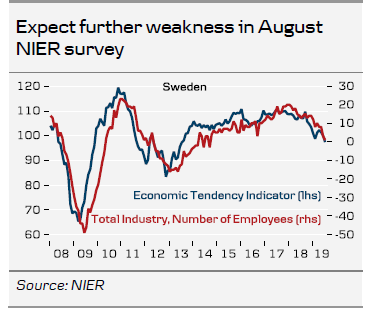
In Norway, we expect a broad-based increase in mainland GDP of 0.8% q/q in Q2, with strong growth in construction, government demand and manufacturing. This would be well above trend and mean that capacity utilisation is increasing further. It would also confirm our view that the Norwegian economy has so far managed to absorb the global slowdown, probably due to high oil investment and government demand. If we are right, these figures in isolation will be a good argument for Norges Bank continuing to normalise interest rates. The week also brings NAV’s unemployment figures for August. The past couple of months have seen a worrying change in the downward trend of the past three years. On the other hand, vacancies have continued to climb, so we see the jobless rate holding at 2.3% in August.
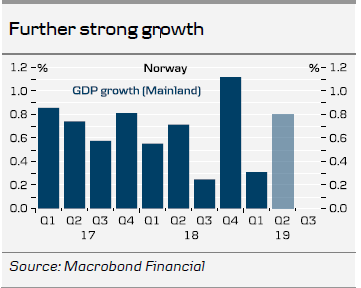
Market movers ahead

Weekly Wrap-Up
Markets take a breather
Main macro themes
We published an update on our outlook for the global economy yesterday (see Global Economic Update - Stuck in the mud but no hard landing yet). Our new basecase of no solution to the trade war between China and US ahead of the 2020 US presidential election has led us to downgrade our growth trajectory for both advanced and emerging markets.
Regional Fed chiefs this week downplayed the case for further rate cuts ahead, in the absence of a significant slowdown. The FOMC minutes from the July meeting had already revealed a very divided Fed on this topic. Still US inflation expectations continue to slide and the August US manufacturing PMI slipped back below 50 for the first time since 2009, setting the stage for more Fed rate cuts ahead (see Presentation: Five more cuts from the Fed [chart pack], 20 August).
The euro area manufacturing PMI recovered some ground in August but at 47.0 remained in contractionary territory. Midway through Q3, euro area PMIs suggest the economy should remain in low gear at 0.2% q/q, with the possibility of another German GDP contraction still on the cards. As the economic backdrop remains gloomy, ECB minutes from the July meeting confirmed that a stimulus package is to be unveiled in September but did not give any clues on the exact design and magnitude of policy measures included.
The Italian government of Five Star Movement and League collapsed after Prime Minister Giuseppe Conte resigned on the back of Deputy Prime Minister Matteo Salvini calling for a vote of no confidence on the government. Consultations continue about a new cross-party governing coalition including Five Star and the Partito Democratico party, which seems to be the preferred choice of President Sergio Mattarella to avoid interference with the 2020 budgeting season. However, politicians have a deadline until Tuesday and policy differences remain. Hence, the possibility of a snap election in Q4 remains alive.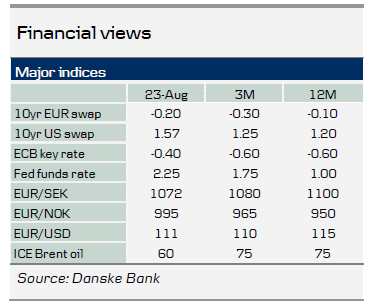
Financial market developments
Despite the government crisis, Italian government bonds rallied on the expectation of a new coalition of a more pro-business and pro-EU government. Germany launched a new 30Y bond, which for the first time was issued with a negative coupon of -0.11%, though demand was underwhelming. Despite the hawkish Fed comments, the US 2s10s yield spread headed towards negative territory again following negative US data surprises.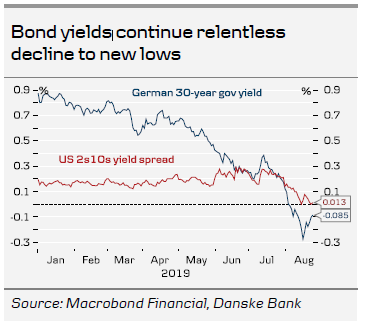
In the FX space, EUR/USD and USD/JPY continued range-trading, as risk sentiment stabilised. The GBP strengthened as the market became more optimistic on the prospect of a Brexit deal following comments from the French and German leaders. In the Scandies, both EUR/NOK and EUR/SEK have been trading sideways to moderately lower this week, driven primarily by the global environment.
Equity markets had a mixed week and continued in a zig-zag pattern, as risk sentiment remained fragile ahead of the G7 meeting at the weekend.
Scandi update
Denmark – signs of labour market weakness but consumers optimistic
Wage earner employment again showed signs of weakness, with only a modest 500 new jobs created in June. The figure fell – by 700 – in May for the first time since April 2013, so these new weak figures indicate May’s downturn was not a one-off fluctuation but that a slowdown is under way in the labour market. There is a real risk that unemployment could increase in the time ahead due to the slowdown in Denmark’s neighbouring economies, though the latest strong economic growth figures for Q2 show the Danish economy remains rather robust and that the bottom is therefore unlikely to fall out of employment for now. Despite these weak labour market figures, consumers appear optimistic about the future.
Statistics Denmark’s consumer confidence indicator hit 6.3 in August, which was markedly higher than July’s 2.9. While there is uncertainty on the global economy, families’ views on their own finances now and in a year’s time pulled the indicator higher. Indeed, their views on their current financial position have not been better since before the financial crisis. The optimism presumably comes on the back of very low interest rates and decent real wage growth, which has put more money in Danes’ pockets.

Sweden – July LFS likely to make Riksbank rethink its strategy
Unemployment jumped again in July (sharply), which was a (big) surprise. From time to time, these things happen as a result of inflows to the labour force. Not this time around, as the labour force was basically unchanged. Instead, employment registered another decline. One can always claim that the data around summer are unreliable. This may be so but the thing is that basically all job-market indicators point in the same direction. Hiring plans are lower and overtime hours are falling quickly (see Reading the Markets Sweden, 16 August). Vacancies are off the peak and temporary employment is in decline. Employers scaling back on overtime and temporary workers is a significant early indicator.
The labour market is at the core of the Riksbank’s thinking. A strong labour market and high resource utilisation lead to higher wages and, in the end, inflation. It is clear to us that the Riksbank’s unemployment forecast needs a significant revision and it is time for a more fundamental rebuff of the policy strategy. Simply pushing the next hike (in the repo path) out by a quarter may not be enough. Indeed, we would not be surprised if at least one board member (Per Jansson) proposes at the meeting in September that the next step will be a rate cut rather than a hike.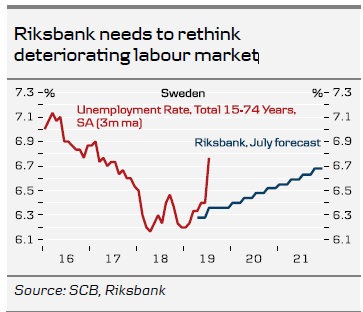
Norway – oil investment set to rise in 2020
As expected, there was little change in the oil companies’ estimates of investment on the Norwegian Continental Shelf in 2019 and 2020. They now expect to invest NOK181.7bn in 2019 and NOK174.0bn in 2020 (as against NOK183.7bn and NOK172.4bn in the May survey). Allowing for the surge related to Sverdrup II in late 2018, the survey points to growth in oil investments this year of around 14% y/y. The downward revision from May could actually be a result of projects being postponed due to capacity problems. The survey also indicates investment growth next year of around 5% in nominal terms, confirming that oil investment is set to make a positive contribution to the Norwegian economy once again in 2020. These figures are no game changer for the markets but do support our expectation of a somewhat longer oil upswing in the Norwegian economy.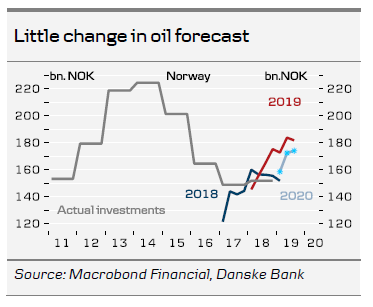
To read the entire report Please click on the pdf File Below..
